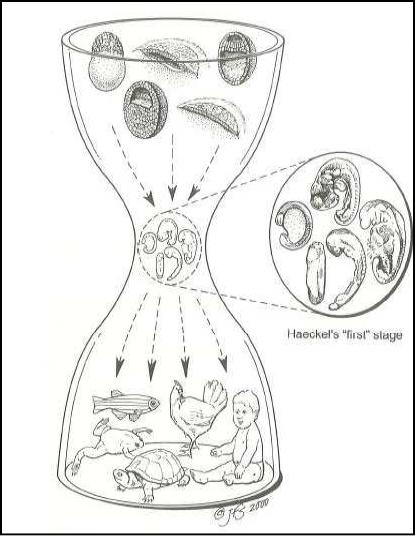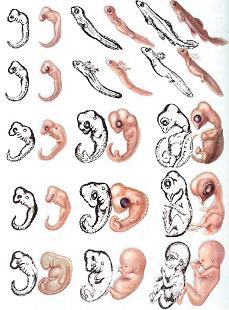 Education
Education
 Evolution
Evolution
 Life Sciences
Life Sciences
Current Textbooks Misuse Embryology to Argue for Evolution
|
Haeckel’s long-discredited recapitulation theory is not necessarily the bedrock of evolutionary thinking today, yet as documented yesterday, leading authorities acknowledge that his drawings persist in textbooks today. While recapitulation theory may be largely out of current textbooks, current textbooks, still use the drawings to illustrate an allegedly high degree of similarity between embryos at the earliest stages of vertebrate embryonic development. Many textbooks cite such similarities in the earliest stages of vertebrate embryos as evidence for common ancestry. For example, Miller and Levine’s Biology states that “[i]n their early stages of development, chickens, turtles, and rats look similar, providing evidence that they shared a common ancestry.”269 Likewise Belk and Borden’s Biology: Science for Life includes this caption to a picture of a vertebrate embryo: “Similarity among chordate embryos. Vertebrate embryos are very similar in the first stage of their development, shown here in the top row, evidence that they share a common ancestor that developed along the same pathway.”270
These particular texts commendably do not use Haeckel’s drawings, but instead use photographs of embryos. However, there are textbooks in use today, such as Mader’s 2010 edition of Biology, which continue to use Haeckel’s drawings (in Mader’s case, essentially a colorized and slightly altered version of Haeckel’s drawings) and state, “At these comparable developmental stages, vertebrate embryos have many features in common which suggests they evolved from a common ancestor.”271 Indeed, a textbook submitted by the J.M. Lebel publishing company for adoption in Texas in 2003, stated, “All vertebrate embryos closely resemble one another in early development” and used a slightly simplified version of Haeckel’s original fraudulent drawings.272 Thus, Haeckel’s embryo drawings are still used to illustrate a purportedly valid point, namely that vertebrate embryos share early developmental pathways, and that this provides evidence for their shared ancestry. But the evidence shows that the earliest stages of vertebrate embryo development often have important differences that are left out of textbooks.
Some leading embryologists argue that the earliest stages of vertebrate embryo development are very different, and embryos start developing very differently, temporarily converge at a conserved stage midway through development, and then diverge again. Images depicting this conserved stage — called the “tailbud,” “phylotipic,” or “phyarngular” stage — are cherry-picked in textbooks to show similarities between vertebrates, even though the embryos are actually more divergent at earlier stages. As one paper in the journal Systematic Biology explains:
Recent workers have shown that early development can vary quite extensively, even within closely related species, such as sea urchins, amphibians, and vertebrates in general. By early development, I refer to those stages from fertilization through neurolation (gastrulation for such taxa as sea urchins, which do not undergo neurulation). Elinson (1987) has shown how such early stages as initial cleavages and gastrula can vary quite extensively across vertebrates.273
Likewise, Richardson and other embryologists explain that vertebrate embryos start their development looking quite different and become similar only at a middle stage of development:
According to recent models, not only is the putative conserved stage followed by divergence, but it is preceded by variation at earlier stages, including gastrulation and neurulation. This is seen for example in squamata, where variations in patterns of gastrulation and neurulation may be followed by a rather similar somite stage. Thus the relationship between evolution and development has come to be modelled as an “evolutionary hourglass.”274
The “hourglass” model of development is illustrated below, where it shows that vertebrate embryos are actually quite different in their earliest stages of development:275

Copyright Jody F. Sjogren 2000
Textbooks thus typically cherry pick the encircled stage as the alleged “earliest stage” of vertebrate development, when in fact vertebrate embryos at their earliest stages have significant non-trivial differences. Indeed, Richardson and other leading embryologists have called into question the very existence of a conserved “phylotopic” (or “pharyngular” or “tailbud”) stage–commonly portrayed in textbooks as evidence for evolution. In a paper titled, There is No Highly Conserved Embryonic Stage in the Vertebrates: Implications for Current Theories of Evolution and Development, Richardson et al. write the following:
We find that embryos at the tailbud stage — thought to correspond to a conserved stage — show variations in form due to allometry, heterochrony, and differences in body plan and somite number. These variations foreshadow important differences in adult body form. Contrary to recent claims that all vertebrate embryos pass through a stage when they are the same size, we find a greater than 10-fold variation in greatest length at the tailbud stage. Our survey seriously undermines the credibility of Haeckel’s drawings, which depict not a conserved stage for vertebrates, but a stylised amniote embryo. In fact, the taxonomic level of greatest resemblance among vertebrate embryos is below the subphylum. The wide variation in morphology among vertebrate embryos is difficult to reconcile with the idea of a phylogenetically-conserved tailbud stage, and suggests that at least some developmental mechanisms are not highly constrained by the zootype. . . .Contrary to the evolutionary hourglass model, variations in the adult body plan are often foreshadowed by modifications of early development. A good example is the aortic arch system in the rat that, even during the pharyngula stage, begins to presage the adult pattern of arteries. Thus the first arch has already broken down completely by the 25-somite stage in the rat (de Ruiter et al. 1989).
In summary, evolution has produced a number of changes in the embryonic stages of vertebrates including:
1. Differences in body size
2. Differences in body plan (for example, the presence or absence of paired limb buds)
3. Changes in the number of units in repeating series such as the somites and pharyngeal arches
4. Changes in the pattern of growth of different fields (allometry)
5. Changes in the timing of development of different fields (heterochrony)
These modifications of embryonic development are difficult to reconcile with the idea that most or all vertebrate clades pass through an embryonic stage that is highly resistant to evolutionary change. This idea is implicit in Haeckel’s drawings, which have been used to substantiate two distinct claims. First, that differences beteen species typically become more apparent at late stages. Second, that vertebrate embryos are virtually identical at earlier stages. This first claim is clearly true. Our survey, however, does not support the second claim, and instead reveals considerable variability — and evolutionary lability — of the tailbud stage, the purported phylotypic stage of vertebrates.276
Former NCSE staff member Matzke co-writes that complaints about the use of Haeckel’s drawings is a “manufactured scandal.”277 Not only are textbooks using inaccurate drawings, but they are using them to illustrate points that are highly disputed by leading embryologists. The earliest stages of vertebrate embryos are quite different and the existence of the cherry-picked conserved stage often portrayed in textbooks as evidence for common ancestry is being called into question.
To say the least, students who are taught that the earliest stages of vertebrate embryos are highly similar, without being told of significant embryological evidence that challenges that view and the very existence of the conserved developmental stage portrayed in many textbooks, are not being adequately informed about the evidence regarding evolution.
[Note: This excerpt is adapted from Casey Luskin, “The Constitutionality and Pedagogical Benefits of Teaching Evolution Scientifically,” University of St. Thomas Journal of Law & Public Policy, Vol. VI (1): 204-277 (Fall, 2009). For the full article, click here]
References Cited:
[268.] Michael K. Richardson et al., There is No Highly Conserved Embryonic Stage in the Vertebrates: Implications for Current Theories of Evolution and Development, 196 ANATOMY AND EMBRYOLOGY, 91, 92–104 (1997) (internal citations omitted).
[269.] KENNETH R.MILLER & JOSEPH LEVINE, BIOLOGY 385 (2008).
[270.] See COLLEEN BELK & VIRGINIA BORDEN, BIOLOGY: SCIENCE FOR LIFE 240 (2d. ed. 2007).
[271.] SYLVIA S.MADER, BIOLOGY 278 (10th ed. 2010).
[272.] See DISCOVERY INST., supra note 228, at 23.
[273.] Andres Collazo, Developmental Variation, Homology, and the Pharyngula Stage, 49 SYSTEMATIC BIOLOGY 3, 9 (2000) (internal citations omitted).
[274.] Richardson et al., supra note 268, at 92 (internal citations omitted).
[275.] The Embryonic Hourglass as published in JONATHAN WELLS, ICONS OF EVOLUTION: WHY MUCH OF WHAT WE TEACH ABOUT EVOLUTION IS WRONG 100 (2002). Diagram Copyright 2000 by Jody Sjogren.
[276.] Richardson, supra note 268, at 91, 105.
[277.] Matzke & Gross, supra note 262, at 41.

